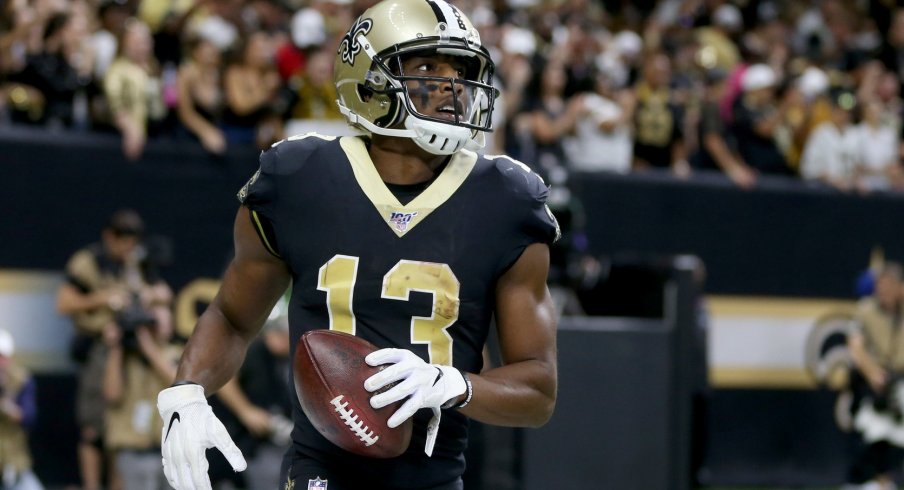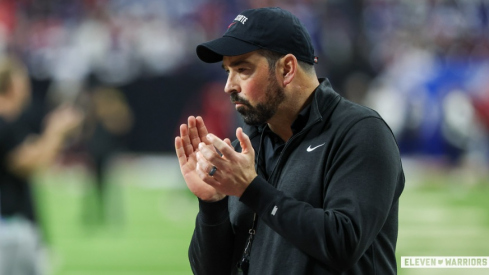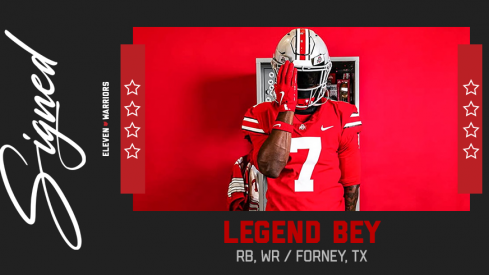While it remains unclear when the Ohio State football team will again take the field, many former Buckeyes are currently preparing for the upcoming NFL season. As we get closer to professional football kicking off, Film Study will take a look at some of the more prominent players who once donned the Scarlet & Gray and now stand out on Sundays.
First up: Michael Thomas of the New Orleans Saints
Michael Thomas didn't take the most direct path to stardom.
Despite being the nephew of one of the NFL's most famous receivers of the 1990s, Keyshawn Johnson, Thomas was more focused on basketball as a youth. But after he led the state of California with 1,656 receiving yards and 21 touchdowns as a senior in high school, it was clear that his future was on the gridiron rather than the hardwood.
Yet despite his gaudy statistics, he didn't spend the following season on the campus of a Power-5 program. Instead, he wound up across the country at Fork Union Military Academy in Virginia, where he teamed up with a massive quarterback from Cleveland who was slated to join Jim Tressel at Ohio State after a post-graduate year at FUMA. When Urban Meyer took over the Buckeye program in 2012, he honored Cardale Jones' scholarship and extended one to his prep school teammate as well, just the third scholarship offer sent Thomas' way.
After a quiet freshman year in which he caught just three passes, Thomas took the unorthodox step of redshirting in his second season. As the Buckeyes entered their magical 2014 campaign, Thomas emerged as the starting X receiver and led the team in receptions with 54, highlighted by a toe-tapping touchdown catch in the Sugar Bowl.
Thomas would again lead the team in catches and in receiving yards as well the following year but earned just third-team All-Big Ten honors as the Buckeye offense often sputtered that fall. Despite failing to garner much attention on the awards circuit, Thomas still declared for the NFL draft following the season, finishing his career in Columbus with 113 catches for 1,602 yards and 18 touchdowns.
Despite solid, if unspectacular numbers as a collegian, New Orleans selected him with the 47th pick in the 2016 draft. The Californian fit seamlessly into Sean Payton's explosive offense and certainly benefited from playing with an all-time great QB in Drew Brees. He hauled in 92 catches for 1,137 and 9 touchdowns and was named to the PWFA All-Rookie team alongside former college teammates Ezekiel Elliott and Joey Bosa during his first year as a pro.
While Payton and Brees have thrived in their time together in New Orleans, tallying over 65,000 passing yards, eight playoff appearances, and a Super Bowl win since joining the Saints in 2006, Thomas's presence has reinvigorated the duo and kept the Saints in contention for a second championship.
Payton's system has deep roots in the West Coast system, having worked with Jon Gruden and Bill Callahan in the 1990s. Once he and Brees connected in New Orleans, the play-calling head coach incorporated a number of downfield passing concepts into his timing-based scheme, stretching the field both horizontally and vertically.
For years, the beauty of the system was its flexibility, as numerous receivers could be plugged in easily while Brees simply found the open man rather than focusing on one lead receiver. Despite the countless completions and yards racked up the Saints' trigger-man, the only Saint receiver to earn Pro Bowl honors before Thomas came to town was tight end Jimmy Graham.
While Thomas had technically left college a year early, he was physically prepared for the league by that point thanks to his prep school and redshirt seasons. Today, he has become one of the most physical wideouts in the game, capable of overpowering most defensive backs and using his 215 lb frame to run through tacklers.
At 6'3" he's an obvious red-zone threat and was targeted 22 times inside the 20-yard line last season, the second-highest total in the league. He doesn't just succeed near the goal line because of his size, though, as he has shown an uncanny ability to read defenses and adapt routes as needed.
Just as in the example above, Thomas lines up in the slot and runs a quick slant below.
As he breaks inside, however, Thomas recognizes that the inside linebacker is bracketing him and looking to blow up the route. So, the savvy receiver quickly plants his inside foot and breaks back outside, executing a perfect swim move over the slot defender in the process and finding open space in the flat.
Going back to his days at Ohio State, one of Thomas' greatest skills has been his ability to separate off the line, using his hands to keep defenders from disrupting his route. Such prowess makes him invaluable to the Saints running game, as Brees will often execute pre-snap Run-Pass Options when he sees a matchup in which the big wideout can create space for a quick gain while the rest of the defense is focused on stopping the run.
Payton will typically line up Thomas as the lone receiver to one side in 3x1 sets, looking to isolate him one-on-one against a corner whom they know he can beat. The same physicality that makes him so dangerous on quick slants is also evident on back-shoulder fades, as he's able to fight off any contact to haul in passes down the sideline.
One of Payton's biggest strengths is his ability to draw up mismatches in Thomas' favor, and versatile running back Alvin Kamara provides an excellent counterweight to draw a defense's attention.
As seen below, the Saints start in a typical 3x1 set with Thomas alone on the left. When Kamara shifts out wide to that side, it not only gives Brees a signal that the defense will be in zone coverage, but it lines up Thomas against a linebacker in the slot.
The Titan defense has a check ready for such occasions, and they clearly signal to change their coverage to a version of Palms/2-Read: a zone-match coverage similar to classic Cover-2 in which the defenders read the actions of the #2 receiver (Thomas in this case) to dictate who picks up which route.
But with a hard step inside before breaking on a quick out, Thomas creates enough space to complete the short pass before the defense picks up either route to that side, resulting in a first down.
While Thomas may be the league's most effective and efficient receiver on quick routes underneath, that's not all he can do. With Ted Ginn on the roster last season, it made more sense for Ginn to take the top off opposing defenses with his elite speed while Thomas worked behind him.
Concepts such as Yankee proved difficult for defenses to stop, as Thomas' ability to track the ball in the air and adjust accordingly turned routes that appear to be covered to turn into big gains.
Thomas thrives as the middle option in three-level vertical concepts like Yankee or Sail/Flood (below), as he creates space for himself downfield just as effectively as he does at the line of scrimmage, using his hands to not only fight off a jam but to deliver a shot of his own.
Of course, none of this matters if Thomas isn't also one of the most sure-handed players in the league. Thomas led the NFL in both targets (180) and catches (149) last season, but surrendered just 6 drops.
As of this writing, Thomas is the holder of at least 25 NFL records, including the most receptions by a player in a single season, the most consecutive games with 4+ receptions (43), and the most receptions by a player through his first four seasons (470). But his most impressive feat may be the way in which he's reshaped the Saints' offense to center around him.
For over a decade, the Saints' lack of reliance on one target was its greatest strength, as Brees could keep defenses from keying on one player. Talented playmakers like Jeremy Shockey, Marques Colston, Reggie Bush, and the aforementioned Graham all found success with the Saints, but the most any single player was ever targeted by Brees was Colston's 2007 season in which he drew 21.9% of the QB's passes. Thomas, on the other hand, has exceeded that number in each of the past three seasons, drawing over 30% of Brees' total targets last fall.
Perhaps even most impressively, Thomas' production didn't fall off last season when Brees missed six games due to injury and the duo of Teddy Bridgewater and Taysom Hill filled in. The combined passer rating for all QBs targeting Thomas in 2019 was 123.3; a mark 10 points higher than that of league MVP Lamar Jackson's rating for the season.
EA Sports rewarded Thomas' production with a 99 overall rating in this year's edition of the Madden franchise - the only receiver to earn such recognition. Now, Xbox and Playstation owners will finally understand what NFL defensive backs have been forced to accept for some time: that they can't guard Mike.



